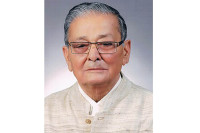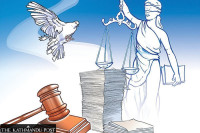National
No policy to counter disinformation
Observers call for media literacy from an early age to enable people to understand and tackle misinformation and disinformation.
Prithvi Man Shrestha
On the eve of the November 20 general elections, screenshots purporting to be of a secret circular issued by the Nepali Congress urging its supporters not to vote for candidates from the immediate coalition partner—CPN (Maoist Centre)—went viral on social media.
The purported secret circular ordered the NC followers not to vote for Maoist Centre candidates other than party chairperson Pushpa Kamal Dahal. Screenshots that appeared as snippets of news based on the ‘secret circular’ from outlets such as Onlinekhabar, Naya Patrika, Setopati and Ujyalo Khabar also went viral.
Later, Nepal Check, a fact-checking site, confirmed that the media outlets had not published any such news. In fact, the screenshots were doctored and uploaded on social networking sites with the intent of spreading false information. Later, the said media organisations clarified that those screenshots were false.
Several fake videos and photographs of Yeti Airlines crash in Pokhara were also circulated widely on social media last month.
“When big accidents like a plane crash and earthquakes happen, people face an information gap about what is happening and they tend to share whatever they find on social media,” said Deepak Adhikari, editor of Nepal Check.
People also circulate fake news on social media to take advantage of others. “During elections, there is a tendency among political parties and their leaders to incorrectly highlight their own party’s or their candidate’s accomplishments while undermining the works of the rival candidates and parties,” Adhikari said, adding that the secret circular purportedly issued by Nepal Congress not to vote is an example of how disinformation is being used to benefit one party against another.
Similarly, a lot of fake videos and news have been circulating about the Turkish earthquake. The Guardian reported on February 14 that such false videos are affecting relief efforts. People and organisations may be using footage they see online to help identify those affected or reunite people with missing family members.
It is not that fake news was not spread in the past, but what social media has done is to amplify them geometrically, according to media observers. Irrespective of who produced the false news, photographs, and videos, social media have become the vehicles to spread them to wider masses quickly, creating false impressions about what happened.
Centre for Media Research, a media research organisation, reported in June last year that more than nine of 10 social media users in Nepal receive misinformation online.
As per its ‘Nepal Social Media Users Survey 2021’, as many as 91.8 percent of the respondents said they have seen misinformation online in the previous seven days whereas 7.5 percent said they have not seen any disinformation online over the past one week.
Facebook is the biggest platform where Nepali social media users saw disinformation, according to the survey, followed by YouTube and Twitter. There are three categories of false information—misinformation, disinformation, and malinformation.
Misinformation is just false information not intended to harm anybody. But some people tend to take monetary advantage of misinformation such as presenting misleading thumbnails on YouTube, according to Adhikari.
Disinformation is information deliberately spread to deceive people to take advantage of certain things at the cost of others.
Malinformation is information that is true and factual, but is intentionally conveyed in order to inflict actual harm on others such as phishing, doxing, swatting and revenge porn.
Cyber Bureau of Nepal Police data shows that incidents of revenge porn are on a rapid rise. During the first six months of the current fiscal year 2022-2023, as many as 680 cases of revenge porn have been registered, according to the bureau.
In the last fiscal year, 1,011 such cases were registered with the bureau. With disinformation, misinformation, and malinformation overloading social media, separating factual information from false one has become increasingly difficult, observers say.
So what can be done to tackle the misinformation, disinformation, and malinformation and what are the best practices?
Observers say one of the lacking aspects is that the government still does not have a national policy and law on controlling false information. The Electronic Transactions Act, of 2063 (2008) prohibits the publication of illegal material in electronic form but does not cover the issue of disinformation entirely, according to them.
“The country needs to have a national policy to tackle misinformation and disinformation, while adopting the policy, it must embrace democratic values,” said Kiran Chapagain, a researcher on cross-border disinformation who worked as a consultant for the Election Commission before the recent elections.
“There is a thin line between the regulation of media and the freedom of expression,” said Chapagain, who is also a former journalist. “So the regulation should be conducted in such a way that the freedom of expression is not curtailed.”
The government in 2019 introduced the Information Technology Bill which would supersede the existing Electronic Transaction Act. But it invited criticism from the stakeholders for its wide-scope nature and the vague language used in the provisions that could give broad powers to the authorities to block social media platforms, if they are not registered in Nepal, threatening to curtail freedom of speech online as well through increased surveillance of personal data and also had more red tape for internet-based companies.
In India, the Ministry of Electronics and IT proposed a draft amendment to IT rules that any news that has been identified as ‘fake’ or false by the Press Information Bureau’s fact-checking unit or other Union government agencies will have to be taken down by all social media platforms.
The opposition political parties and journalists’ bodies have slammed the Indian government’s proposal claiming that allowing the government entity to determine what is fake or not would curtail freedom of expression and freedom of the press.
“The German government fines the social media company for not taking down fake news, adhering to the democratic values without compromising on freedom of expression,” said Chapagain. “Some other countries including Russia and Venezuela curtailed the freedom of expression while implementing similar provisions.”
Though Nepal does not have a national policy to counter disinformation, specific state bodies have started to introduce the policy. For example, the Election Commission introduced the ‘Policy on the use of social media in Electoral Management, 2077 which talks about controlling misinformation and disinformation in election management and developing an institutional system and competent human resources to ensure the authenticity of the source of information and regulate misinformation, disinformation, distorted information, miscommunication, and distorted news that are disseminated through social media.
The commission mobilised cyber security experts from Nepal Police and Nepal Army to monitor social media content around the provincial and federal elections.
Though the commission clarified that security personnel were mobilised to ensure that no cybercrime is committed, the move invited criticism from the press bodies and media advocacy groups arguing that the mobilisation of security personnel could affect freedom of expression.
In its elections code of conduct, the commission also barred all the stakeholders from transmitting disinformation, misinformation and hate speech on social networks, or cause to do so.
“As part of social media monitoring, it was looked at whether domestic and crossborder disinformation would affect the integrity of elections and disinformation could hamper peace and security during the elections,” said Chapagain, who had advised on the issue to the election body.
While these are the reactive measures to control misinformation and disinformation, observers say that public awareness about false information is a must to ensure that false information would not lead to unwanted activities.
“Fact-checking, media literacy, and making social media companies accountable are some of the measures that can be taken to lessen the spread of fake news,” said Adhikari. “Media literacy among people is a must to enable people to judge whether the information they received was correct and the government should order the social media companies to invest in Nepal to tackle misinformation, particularly that in the Nepali language.”
Parashuram Kharel, professor of Mass Communication at The Tribhuvan University, said discussions on misinformation and disinformation have been inadequate compared to the scale of false information spread on social media. “There is also a need to take strong legal action against the spreader of false information that would have a demonstrative effect on others,” he said.
Not only grown-up people, but even children have become victims of false information as they are exposed to social media from an early age, according to observers.
“It is necessary to include cyber security and social media literacy as part of the school curriculum so that children can learn to tackle misinformation and disinformation from an early age,” Chapagain said.




 14.12°C Kathmandu
14.12°C Kathmandu














